As per history, Tantrik Shakti worshiping was started from 7th. Century onwards in which it is believed that mother goddess is the source of power (Shakti) and highest spiritual bliss. Shaktism, in which power of mother goddess (Matrushakti) is depicted as the ultimate form of power, continued to dominate Buddhism, Shaivisim and Bramhinism after 7th. Century. During this period mother energy was conceived and expected in various ways and the image of Siva accompanied by his consort is conceived as Ardhanariswara (half male half female).
During the early Bhaumakar rule 736 A.D the eight armed Mahinsamardini Durga appeared in the sculptural masterpieces of Orissa. Some eight armed Mahinsamardini idol (Bigraha) seen in some other part of Orissa in the eighth century had resemblance with Goddess Sarala. As per the eminent archaeologists and scholars the period of origin of the Goddess Sarala in Jhankad was during 8th. Century A.D.
Tantrik Culture of the place: Goddess Sarala was popularly known as ‘Sarola Chandi’ till fifteenth century as it is stated in Oriya Mahabharat.
Chandi or Sapta Sati interpolated in the Makandeya Purana known as one of the Shakta Tantrik text of brahimincal religion. The entity and culture of the goddess Sarala has been derived from the Sapta sati Chandi written by great sage Markandeya. As per the description in the text Goddess has retained Shiva’s trident, Vishnu’s Chakra, Vayu’s bow, Surya’s arrow, Bishwakarma’s sword. Indra’s thunder, Ayirabata’s bell and Himaban’s Lion. It is considered as the main source of the idol Godess Sarala. Chanting of sacred verses of Sri Chandi is one of the most learned practices inside the temple. Everyday chanting of the sacred text at the Shrine not only one of the important rituals but it is very portative for devotees.
Tantrik aspects of ritual are still in practice from time immemorial, which is the witness to the undeniable fact that is a great Shakta Tantrik peetha. The aspect of Pancha “MAA” Kara puja by Panada Pujak is found in the daily rituals.
Ghata Nrutya as it is being performed by the “Roul”, the Sevak of Goddess is another aspect of Tantrik worship. Roul is described as a Tantrik (Maha Gunia) in Oriya Mahabharat. A wooden stand carrying potful of water (Ghata) is decorated in flowers. Roul Sevak wearing Sarees, Bangles (Khadu), ankle (Pahuda), vermilion (Sindoor), Kajala different types of ornaments. Decorating himself in a mythological picturesque manner heading the Ghata without any support gives swinging dances. It is supposed that the will of the Goddess is acted in dance form of the Roul. The ritual seems to be one of the oldest customs of Shakta tantrism as has been adopted in different Shakti Peeths.
The practice of animal sacrifice (which has been discontinued since long) on the occasion of Mahastami Sandhi Puja, Dussehra is another witness of Shkata tantrik peeths, though the ritual is not in vogue at present.
Attribution of entity as Saraswati: The Goddess Sarala known as Vakdevi is conceived as the active and eternal source of all wisdom, intelligence and inspiration. The deity personifies “Bramha-Vidya” (the mystic knowledge of the absolute), that is the topmost religious concept in the perspective of dakshinachara Shakti Cult. She is also known as Utkal Bharati, where Utkal signifies the state of Orissa and Bharati is one of the epithets of Saraswati.
It is believed that the substance of life and the power of knowledge are given by the Goddess and therefore the other name of the Goddess is “Sarada” This belief was authenticated in the 15th. Century AD. Sidheswara Parida, a devotee belongs to a traditional farmer family adopted his name “Sarala Dasa”(servant of Maa Sarala) by the name of his beloved Goddess. Later on Sidheswara was designated as the foremost poet of Oriya literature by his composition of great epics Oriya Mohabharata, Bilanka Ramayan, Chandipuran and Laxminarayan bachanika. The great poet Sarala Dasa admitted time and again that he had been an illiterate man and composition of the great and epoch-making verses in Oriya Mahabharata was the result of the magic power transferred to him by his beloved Goddess Maa Sarala.
It might have influenced and touched the right chord in the hearts of Oriyas. Any Oriya-speaking person in the field of acting, drama, song, folk dance, literature and creative art pays his highest devotion and regards at the beginning of his performance in the respective field and respective form. The Sarala Thakurani has been the fondest introduction to the artistic excellence, learning and literary brilliance.
All over Orissa there has been spread Shkta culture and a number of temples have been raised in different names like Sarala (Jhankada), Vimala (Puri), Ramachandi (Konark), Bhagabati (Banapur), Kalijai (Chilika), Narayani (Balugaon), Taratareni (Ganjam), Tarini (Ghatagaon), Bhadrakali (Bhadrak), Biraja (Jajpur), Mangala(Kakatpur), Manikeswari (Kalahandi) and Samalei (Sambalpur). They are more or less similar invocation incantation and manner of worship but everywhere through out the state and in the neighbouring states like Jharkhand, Andhra Pradesh, Chhatisgarh and West Bengal (Medinipur). Folk song dances like Pala, Daskathia, Ghodanacha and Opera pay their obeisance to Goddess Sarala. Literary activity, commencement of learning “Vidyarambha”. Her very name invites devotion and protection.
Goddess in Legend:
In Tretaya Yuga, Parasurama theBrahmin warrior and sixth incarnation of Lord Vishnu went round (Tritha Paryatana) sacred places with an aim to establish Goddess Sanctuary (Matru Tirtha) on his way. While moving from places to place, he came near river Chandrabhaga, took a dip in the river and took rest under a banyan tree. While meditating, he came to know about a power (Shakti) kept self-hidden and desired to have self-expression. After that Parasuram recovered a shining stone (Parasmanisila),a wonderful form of glittering Basalt-stone from underneath the earth and carved the divine image of goddess with his arrow. As per the legend the name of the Goddess became Sarada, as the figure of Goddess carved out by arrow (Sara) of Parasurama. The place still bears the legend as meeting banyan tree (Bheta Bara). The name “JHANKARA” or “JHANKADA” is lexically related in the magical reverberations of the sound of Parsurama’s arrow and divine stone.
Another legend relates to the place and the deity to Dakshya Yajna in Devi Puran and other Puranic text. It is said that Sati (Adimata or Adishakti), the original source of power, the wife of Lord Shiva, got herself sacrificed in the fire place (Yajna Sthala) because She could not tolerate humiliation of Her husband by Her father, Dakshya. Out of grief and remorse, Lord Shiva, holding Her corpse on His shoulder started roaming relentlessly. Apprehending the anger of Shiva, which might be detrimental for mankind, Lord Vishnu, sliced Her body into pieces by His great weapon wheel (Sudarsan Chakra) and pieces of Her body scattered over fifty-one places, and around each there grew up a sacred place of worshipping mother goddess (Shakti Peetha). As per the legend, the Navy of Sati fell down in Jaipur, where Goddess Viraja is worshipped and it is know as “Navy Kshetra”, the foot of Sati fell down in Srikshetra, where Goddess Vimala is worshipped and it is know as Pada Peetha and the Tongue of Sati fell down in Jhankada and it is know as “Jiwha /Bani Peetha” (As Jiwha/Bani Peetha, Jhankad lacks puranic evidence). Goddess in Oriya Mahabharata:
Here it is difficult to state devotion and dedication of the great poet Sarala Dasa to his beloved Goddess. But in the great epic Oriya Mahabharat he has stated Goddess Sarala in a different ways. A great Sage named Krupajala could become able to achieve Bramhapada by dint of his meditation and yoga. A beautiful lass was fostered by Maharsi Krupajala. In the mean time, many of years have passed, (Satya, Tretaya, Dwapara and Kali Yuga) the lass remained in the same age. The angel lass revealed the curiosity of her own entity to Maharsi by stating that. 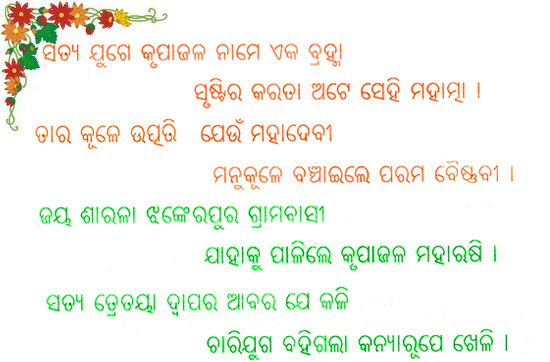
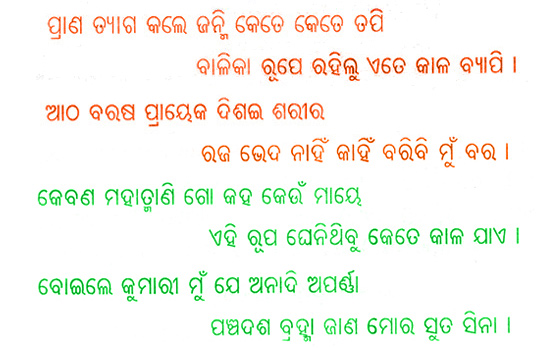
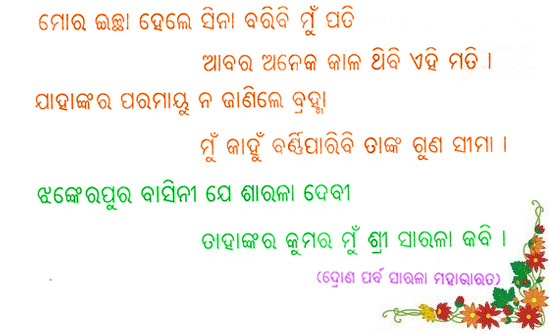 Goddess in other epic text:
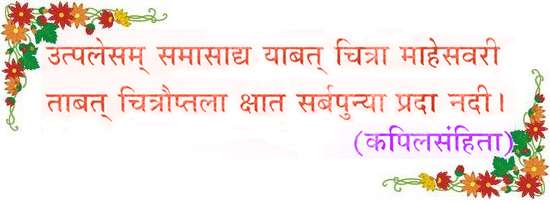
The significance of river Chitropala can be traced in some other epic text. Chitropala and Mahanandi are synonymously used in the historical past. As per the above verse of Kapilasonghita the shrine of Utpaleswara exists at the very outset of the division of the river Chitropala (Mahanandi) and ultimately the said river ends in the place where the shrine of Goddess Chitra Maheswari islocated. Oriya Mahabharat also sates that Utpaleswara is enshrined on the river Chitropala. A verse, Oriya Mahabhart states that the river Chitropala was flowing closer to the shrine of Goddess Sarala It seems that the shrine of Goddess Sarala at Jhankada was close to the river Chitropala in long past. Obviously the term Chitra Maheswari refers to the shrine of Goddess Sarala. It is one of the very ancient synonyms of the Goddess Sarala (Durga) as addressed in many other puranic texts. Some other epic text like Oriya Mahabharat and Chandi Purana have also addressed Goddess Sarala in the name of Chitra Maheswari. In light of folk etymology, the term Chitropala is visualized to have derived from combination of the two words, Chtra Maheswari and Utpaleswara. In the sense those prefix Chitra and Utpala have given rise to the term Chitropala. Niyogi-Sevak(Priest)
“The priest (Niyogi System comprises of several categories, who observes the rites in the temple. Two types of Brhamin priests and some Sudra Sevaks, who work for daily rituals. Among them the Yagnic Brahmins who performs rites like Homa, Jajna, Chandi Patha, all types of vedic rituals. The “Panda” Brahmins, pujaks of the deity are known as “Puja Panda” have all the rights to perform all kinds of rituals. Mainly they do daily rituals like Puja, Arati, and prepares food(Prasad) for the deity. In some important rituals the vedic priests assist them. The “Roul” (Sudra Sevaks) of the deity takes responsibility of bathing(marjana), decoration (Vesa) and arrangement of all types of worshipping materials(Puja Upakarana) in the place. Astrologers read out (panjika) the daily movement of the planets and stars before the deity everyday morning. They also strike cymbals (Ghanta Nada) at the time of Puja and arati and provide some cooking material. Flower provider popularly known as Mali provides flower, bel leaf, tulsi bade at the time of Marjana and Vesa. They also cut vegitables for the preparation of Bhoga(Prasad) and assist in cooking.
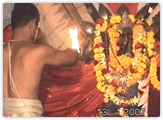 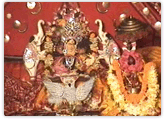 
During the early Bhaumakar rule 736 A.D the eight armed Mahinsamardini Durga appeared in the sculptural masterpieces of Orissa. Some eight armed Mahinsamardini idol (Bigraha) seen in some other part of Orissa in the eighth century had resemblance with Goddess Sarala. As per the eminent archaeologists and scholars the period of origin of the Goddess Sarala in Jhankad was during 8th. Century A.D.As archeological study of the art and architecture of different temples of Orissa, it is quite evident that, the ancient rulers of Orissa (the then Kalinga or Udra) were quite magnanimous and tolerant towards all religious sects. This period witnessed growth of Shakta Tantrik cult in Orissa. Tantrik Shakti worshiping dominated Bhubaneswar, the then epicenter of Saivism. The devotees of Shiva known as Kapalikas were mostly worshiping the Tantrik Goddesses in and around Bhubaneswar. It is evident from a no. of Shakti shrines like Vaital, Mohini, Uttareswari and Dwarabasini around Vindu Sarovar (now known as Vindusagar) near Lingaraj Temple. The Shakti worshipers of Bhaumakar period conceived of worshipping a group of seven mother Goddess (Saptamatruka) accompanied by Ganesh and Virabhadra. |